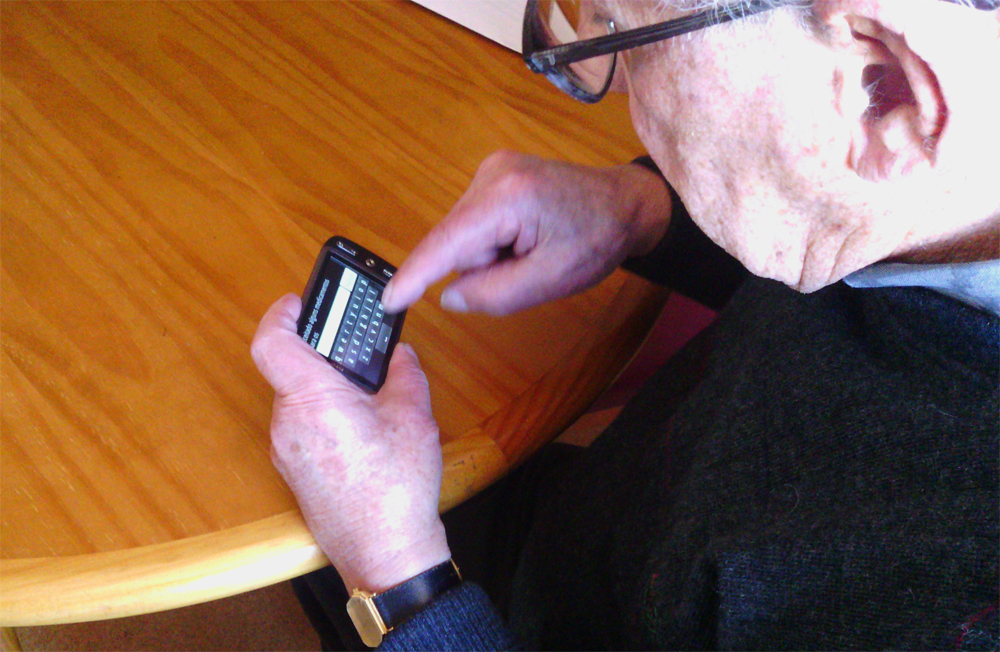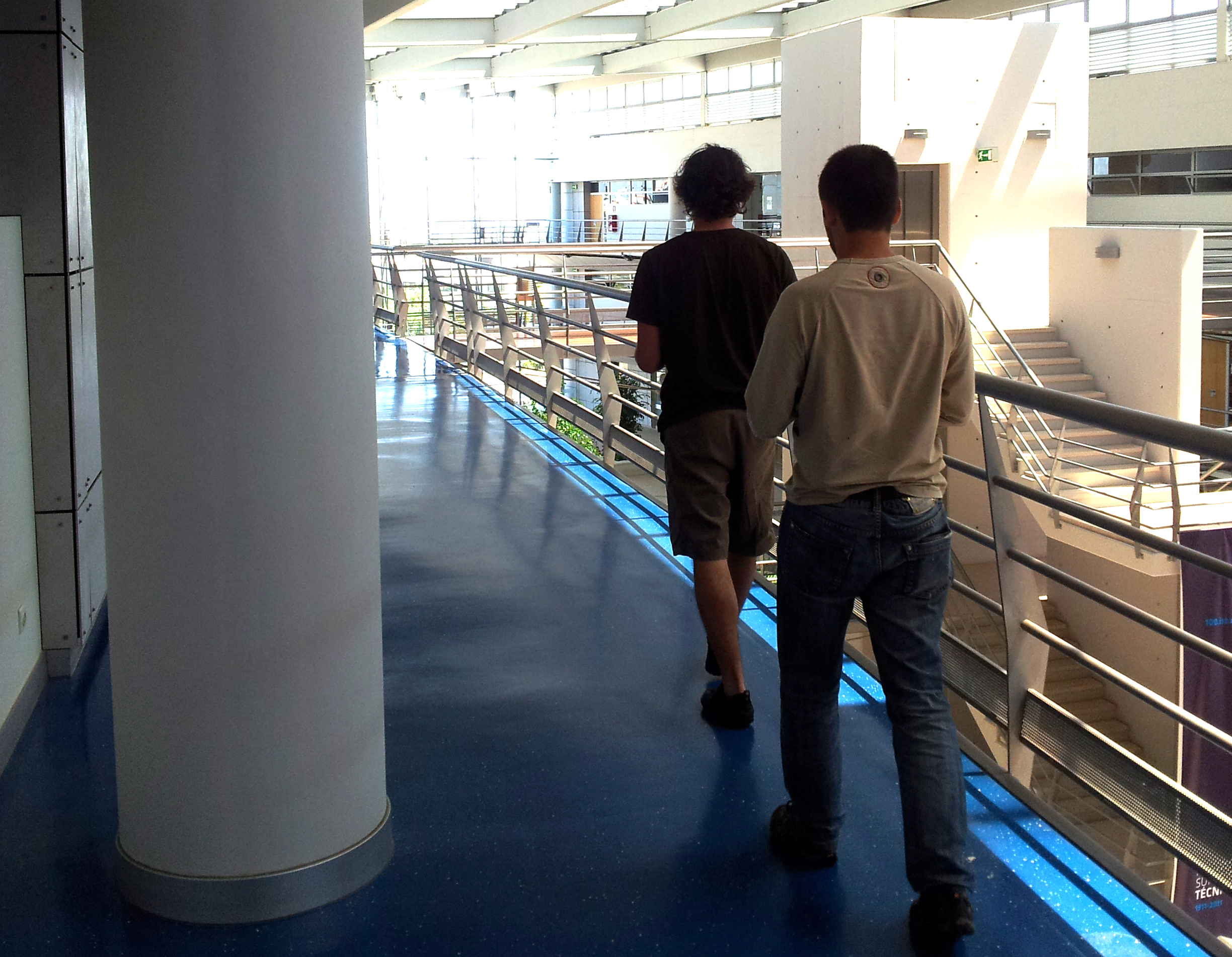Recent advances on mobile technologies are blurring the frontiers between able-bodied and disabled users. Indeed, mobile settings have a negative impact on motor abilities. Mobile users’ bodies are prone to vibrations, resulting in hand tremors, which hinder target selection accuracy. These users seem to share some problems with older adults, who experience increased physiological tremor.
In this work, we propose to bridge the gap between different domains, allowing designers to build more inclusive and comprehensive solutions using recent touch-based devices.
Project Details
Title: Disabled 'R' All
Date: Jan 1, 2017
Authors: Hugo Nicolau, David Lucas, Tiago Guerreiro, Joaquim Jorge
Keywords: touchscreen, mobile, older adults, tremor, walking
Related Publications
- Mobile text-entry and visual demands: reusing and optimizing current solutions
- Hugo Nicolau, Tiago Guerreiro, David Lucas, and Joaquim Jorge. 2014. Mobile text-entry and visual demands: reusing and optimizing current solutions. Universal Access in the Information Society 13, 3: 291–301. http://doi.org/doi:10.1007/s10209-013-0319-y
- [ABSTRACT] [PDF] [LIBRARY]
Mobile devices are increasingly used for text-entry in contexts where visual attention is fragmented and graphical information is inadequate, yet the current solutions to typing on virtual keyboards make it a visually demanding task. This work looks at assistive technologies and interface attributes as tools to ease the task. Two within-subject experiments were performed with 23 and 17 participants, respectively. The first experiment aimed to understand how walking affected text-entry performance and additionally to assess how effective assistive technologies can be in mobile contexts. In the second experiment, adaptive keyboards featuring character prediction and pre-attentive attributes to ease visual demands of text-entry interfaces were developed and evaluated. It has been found that both text-input speed and overall quality are affected in mobile situations. Contrary to the expectations, assistive technologies proved ineffective with visual feedback. The second experiment showed that pre-attentive attributes do not affect users’ performance in task-entry tasks, even though a 3.3–4.3 % decrease in error rates was measured. It was found that users reduce walking speed to compensate for challenges placed by mobile text-entry. Caution should be exercised when transferring assistive technologies to mobile contexts, since they need adaptations to address mobile users’ needs. Also, while pre-attentive attributes seemingly have no effect on experienced QWERTY typists’ performance, they showed promise for both novice users and typists in attention-demanding contexts.
- Mobile touchscreen user interfaces: bridging the gap between motor-impaired and able-bodied users
- Hugo Nicolau, Tiago Guerreiro, Joaquim Jorge, and Daniel Gonçalves. 2014. Mobile touchscreen user interfaces: bridging the gap between motor-impaired and able-bodied users. Universal Access in the Information Society 13, 3: 303–313. http://doi.org/doi:10.1007/s10209-013-0320-5
- [ABSTRACT] [PDF] [LIBRARY]
Touchscreen mobile devices are highly customizable, allowing designers to create inclusive user interfaces that are accessible to a broader audience. However, the knowledge to provide this new generation of user interfaces is yet to be uncovered. The goal was to thoroughly study mobile touchscreen interfaces and provide guidelines for informed design. The paper presents an evaluation performed with 15 tetraplegic and 18 able-bodied users that allowed to identify their main similarities and differences within a set of interaction techniques (Tapping, Crossing, and Directional Gesturing) and parameterizations. Results show that Tapping and Crossing are the most similar and easy to use techniques for both motor-impaired and able-bodied users. Regarding Tapping, error rates start to converge at 12 mm, showing to be a good compromise for target size. As for Crossing, it offered a similar level of accuracy; however, larger targets (17 mm) are significantly easier to cross for motor-impaired users. Directional Gesturing was the least inclusive technique. Regarding position, edges showed to be troublesome. For instance, they have shown to increase Tapping precision for disabled users, while decreasing able-bodied users’ accuracy when targets are too small (7 mm). It is argued that despite the expected error rate disparity, there are clear resemblances between user groups, thus enabling the development of inclusive touch interfaces. Tapping, a traditional interaction technique, was among the most effective for both target populations, along with Crossing. The main difference concerns Directional Gesturing that in spite of its unconstrained nature shows to be inaccurate for motor-impaired users.
- Disabled ’R’ All: Bridging the Gap between Health- and Situationally-Induced Impairments and Disabilities
- Hugo Nicolau. 2013. Disabled ’R’ All: Bridging the Gap between Health- and Situationally-Induced Impairments and Disabilities. Technical University of Lisbon.
- [PDF]
- Disabled ’R’ All: Bridging the Gap Between Health and Situational Induced Impairments and Disabilities
- Hugo Nicolau. 2012. Disabled ’R’ All: Bridging the Gap Between Health and Situational Induced Impairments and Disabilities. SIGACCESS Access. Comput., 102: 21–24. http://doi.org/10.1145/2140446.2140451
- [ABSTRACT] [PDF] [LIBRARY]
More and more people interact with mobile devices whilst walking. This new interaction paradigm imposes a novel set of challenges and restrictions to mobile users, denominated Situationally-Induced Impairments and Disabilities. The tremor originated of such contexts results in inaccurate movements and erroneous actions. These difficulties are particularly visible in recent touch interfaces that lack the tactile cues and physical stability provided by their keypad-based counterparts. Nevertheless, these difficulties are not new to the accessibility community, particularly for those studying motor impaired users. In fact, both user populations (situationally and physically impaired) seem to share similar interaction problems. This work aims to thoroughly understand to what extend technology can be transferred between those domains. Unlike the embryonic stage of mobile research, the accessibility community has the accumulated knowledge of more than two decades of research. Building a relationship between these domains will contribute towards a more inclusive and universal design approach, which will benefit and bring closer two distinct research communities.
- Elderly Text-entry Performance on Touchscreens
- Hugo Nicolau and Joaquim Jorge. 2012. Elderly Text-entry Performance on Touchscreens. Proceedings of the 14th International ACM SIGACCESS Conference on Computers and Accessibility, ACM, 127–134. http://doi.org/10.1145/2384916.2384939
- [ABSTRACT] [PDF] [LIBRARY]
Touchscreen devices have become increasingly popular. Yet they lack of tactile feedback and motor stability, making it difficult effectively typing on virtual keyboards. This is even worse for elderly users and their declining motor abilities, particularly hand tremor. In this paper we examine text-entry performance and typing patterns of elderly users on touch-based devices. Moreover, we analyze users’ hand tremor profile and its relationship to typing behavior. Our main goal is to inform future designs of touchscreen keyboards for elderly people. To this end, we asked 15 users to enter text under two device conditions (mobile and tablet) and measured their performance, both speedand accuracy-wise. Additionally, we thoroughly analyze different types of errors (insertions, substitutions, and omissions) looking at touch input features and their main causes. Results show that omissions are the most common error type, mainly due to cognitive errors, followed by substitutions and insertions. While tablet devices can compensate for about 9% of typing errors, omissions are similar across conditions. Measured hand tremor largely correlates with text-entry errors, suggesting that it should be approached to improve input accuracy. Finally, we assess the effect of simple touch models and provide implications to design.
- The Disability Continuum: Investigating Health and Situational Induced Impairments and Disabilities
- Hugo Nicolau and Joaquim Jorge. 2012. The Disability Continuum: Investigating Health and Situational Induced Impairments and Disabilities. Mobile Accessibility Workshop at International Conference on Human-Computer Interaction with Mobile Devices and Services (Mobile HCI).
- [ABSTRACT] [PDF]
Recent advances on mobile technologies are blurring the frontiers between able-bodied and disabled users. Indeed, mobile settings have a negative impact on motor abilities. Mobile users’ bodies are prone to vibrations, resulting in hand tremors, which hinder target selection accuracy. These users seem to share some problems with elderly people, who experience increased physiological tremor. However, this hypothesis has yet to be thoroughly researched. In this work, we propose to bridge the gap between different domains, allowing designers to build more inclusive and comprehensive solutions using recent touch-based devices. We present two evaluations comparing situational- to health-impaired users and report on the main differences and similarities we found on text-entry tasks. Our results show that while elderly users are more likely to commit cognitive errors, both user groups experience similar substitution errors. We found that the increased demands of mobility and type of device seemingly induce a “disability continuum”, where both situationally- and health-impaired users’ performance is interleaved
- Touch Typing Using Thumbs: Understanding the Effect of Mobility and Hand Posture
- Hugo Nicolau and Joaquim Jorge. 2012. Touch Typing Using Thumbs: Understanding the Effect of Mobility and Hand Posture. Proceedings of the SIGCHI Conference on Human Factors in Computing Systems, ACM, 2683–2686. http://doi.org/10.1145/2207676.2208661
- [ABSTRACT] [PDF] [LIBRARY]
Mobile touch devices have become increasingly popular, yet typing on virtual keyboards whilst walking is still an overwhelming task. In this paper we analyze; firstly, the negative effect of walking on text-input performance, particularly the users’ main difficulties and error patterns. We focused our research on thumb typing, since this is a commonly used technique to interact with touch interfaces. Secondly, we analyze how these effects can be compensated by two-hand interaction and increasing target size. We asked 22 participants to input text under three mobility conditions (seated, slow walking, and normal walking) and three hand conditions (one-hand/portrait, twohand/portrait, and two-hand/landscape). Results show that independently of hand condition, mobility significantly decreased input quality, leading to specific error patterns. Moreover, it was shown that target size can compensate the negative effect of walking, while two-hand interaction does not provide additional stability or input accuracy. We finish with implications for future designs.
- Investigating the Effectiveness of Assistive Technologies on Situationally Impaired Users
- David Lucas, Hugo Nicolau, Tiago Guerreiro, and Joaquim Jorge. 2011. Investigating the Effectiveness of Assistive Technologies on Situationally Impaired Users. Mobile Accessibility Workshop at IFIP TC13 Conference on Human-Computer Interaction (INTERACT).
- [ABSTRACT] [PDF]
Mobile devices are used in increasingly demanding contexts, which compete for the visual resources required for an effective interaction. This is more obvious when considering current visually demanding user interfaces. In this work, we propose using solutions initially designed for blind people in order to ease the visual demand of current mobile interfaces. A comparative user study was conducted with 23 sighted volunteers who performed text-entry tasks with three methods, QWERTY, VoiceOver alike and NavTouch in three mobility conditions. We first analyzed the effect of walking and visual demand, followed by the effect of using assistive technologies in mobile contexts. Results show that traditional QWERTY keyboard outperforms alternative textentry methods for the blind, as users prefer visual feedback over their auditory counterpart. Moreover assistive technologies and their interaction processes revealed to be cognitively demanding and therefore inadequate in mobile contexts. These findings suggest that technology transfer should be performed with caution, and adaptations must be done to account for differences in users’ capabilities.

